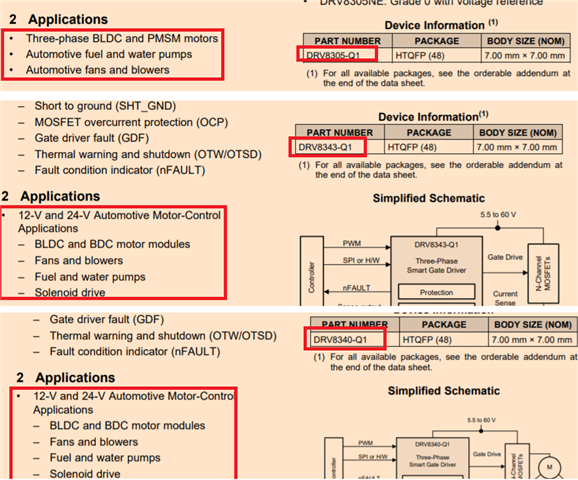Is it necessary to select a chip with 3 op-amp detecting 3-phase current?
Many chips with only one op-amp to detect the total phase current.
This thread has been locked.
If you have a related question, please click the "Ask a related question" button in the top right corner. The newly created question will be automatically linked to this question.
Is it necessary to select a chip with 3 op-amp detecting 3-phase current?
Many chips with only one op-amp to detect the total phase current.
Hello Zhengwei,
Thanks for posting to the MD forum! It is not necessary to use a chip with 3 current sense amplifiers, and possible to use only one current sense amplifier. If you wish to only look at total current and not the current per phase you can tie all the phases together and use one CSA, the extra 2 remaining CSAs can remain unused all that needs to be done is ground the inputs and float the outputs.
If you are looking for automotive parts you should be able to use DRV8305-Q1 or DRV8343-Q1 for this application. These all have three CSAs so the workaround mentioned above would have to be used.
If you are not looking for automotive parts then you should be able to use DRV8328 which only has one CSA.
Best,
Isaac
According to https://www.ti.com/lit/an/slvaes1/slvaes1.pdf?ts=1641455745129&ref_url=https%253A%252F%252Fcn.bing.com%252F guideline,
sunroof controller belongs to "torque" application.

By TI BLDC driver website selection filter, 3 chips are selected(DRV8340-Q1, DRV8343-Q1 & DRV8305-Q1).
These 3 chips datasheet application description as below and they are fit for "Speed " type application, but "torque" type application not mentioned.

Are these 3 chips suitable for "torque" type application?
Also about control method, Trap & FOC can be used in "torque" type application. DRV8340-Q1 & DRV8343-Q1 can support Trap control,
if need to use FOC control method, how to use DRV8340-Q1, DRV8343-Q1 & DRV8305-Q1.

Hello Zhengwei,
We have had customers use these devices in the past for sunroof motor applications.
DRV8343-Q1, DRV8340-Q1, and DRV8305-Q1 are all external control devices which means they support either trapezoidal or FOC control. All three devices support an integrated trapezoidal control method when using 1x PWM mode, this uses the states of the hall sensors to check the state of the motor and apply the trapezoidal commutation algorithm. The voltage applied on the motor depends on the PWM duty cycle that is applied to the device.
If you would like to use your own trapezoidal or FOC algorithm you can use the device in 6x PWM mode and create your own firmware to drive the motor. Trapezoidal control methods are easier to code and create while FOC are the most complex to create.
Here is a precision labs video that talks about the different commutation methods: https://training.ti.com/ti-precision-labs-motor-drivers-comparison-commutation-methods
Best,
Isaac